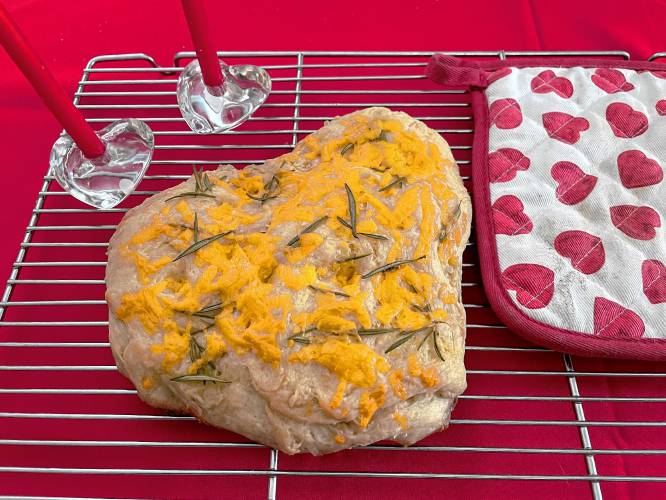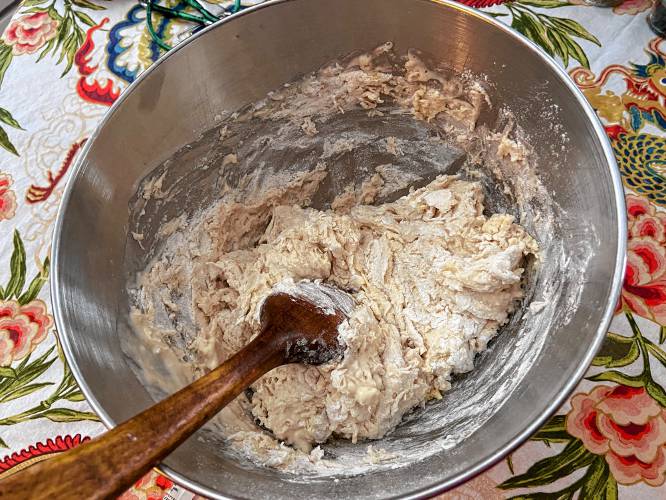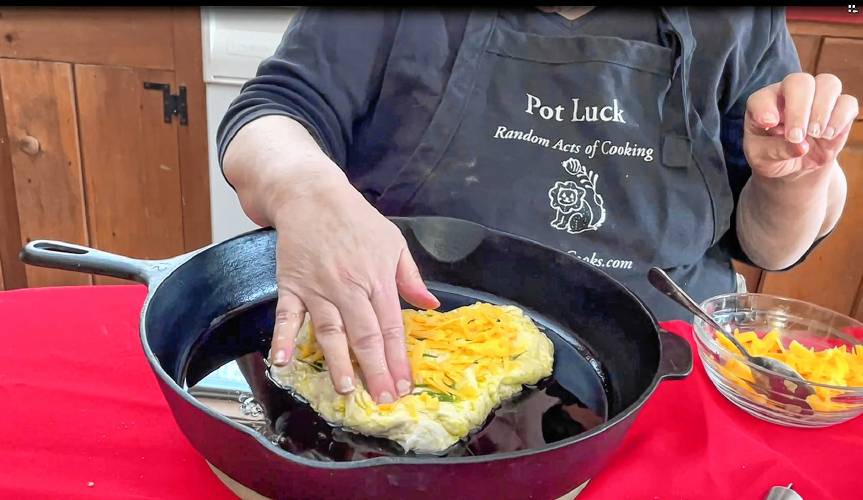Focaccia is for lovers: Nothing is as cozy as a freshly baked bread on a cold day
|
Published: 02-13-2024 11:21 AM
Modified: 02-13-2024 3:46 PM |
At this time of year, when the weather is still cool, baking is a pleasure … almost a necessity. Baked goods warm us up when we eat them. The word “calorie,” after all, represents a measure of heat. Moreover, the mere act of turning on the oven makes the house cozier.
Bread in particular feels just right in the winter. The whole process — kneading, waiting for rises, baking, sharing with family and friends — somehow makes the days less dark and chilly.
I was hoping to bake bread to give to valentines this year. Unfortunately, I haven’t had the time to go through the whole process lately. Several of my jobs seem to have expanded in recent weeks. I almost resigned myself to abandoning my bread-baking plan … until I remembered focaccia.
Focaccia, as readers probably know, is an Italian bread that is sort of a cross between pizza dough and a regular loaf. It’s an ancient type of flatbread; it has been baked for centuries — perhaps millennia — in Italy, probably originating with the Romans’ forebears, the Etruscans.
Like most bread in those times, it was baked over coals in hearths. Its name comes from “panis focacus,” hearth bread in Latin. Over the centuries it developed into a simple peasant bread, the sort of thing workmen could take on the job for a lunchtime nosh.
Focaccia’s biggest selling point for a busy baker like me is that it is a no-knead bread. It does most of the work all by itself. After one proofs the yeast (which doesn’t take more than five minutes), one throws the dough together and then lets it rise for a couple of hours on its own, partly covered.
After those two hours, one can either bake the bread right away or cover it completely and refrigerate it for several hours or overnight. I prefer the latter method; if you want to bake the bread right away, you’ll need to flour your hands well to keep the dough from being too sticky.
Focaccia’s other major virtue is its mixed consistency. The relatively large amount of water in the recipe helps the bread develop lots of holes, resulting in a chewy, airy loaf. The olive oil used to grease the pan and drizzle on top of the bread helps the top and bottom crisp up, contrasting nicely with the interior.
Article continues after...
Yesterday's Most Read Articles
I bake my focaccia in a cast-iron skillet. If you don’t have a cast-iron skillet, I heartily recommend that you go out and purchase one. The Lodge manufacturing company even pre-seasons its cast-iron products to make them easier to use.
If you don’t have the time or financial resources to get a cast-iron pan, you may of course use a well oiled cake pan or rimmed cookie sheet. Don’t forget to oil the sides as well as the bottom. Your focaccia may lose a little of its crispiness, but any homemade bread is better than none!
Like pizza crust, its thinner cousin, focaccia can be covered with a variety of toppings. My most recent loaf used only two (plus olive oil), aromatic rosemary and colorful cheddar cheese. It was delicious.
Feel free to experiment with different herbs and cheeses, as well as vegetables and olives. My friend Vicky, who is more artistic than I, likes to use veggies to draw a colorful picture on her loaves. Extra salt crystals on top add zing.
This recipe makes a small loaf (heart shaped for Valentine’s Day, although that’s not obligatory), perfect for four people. The recipe may certainly be doubled.
Just be sure to use a big enough pan to accommodate your dough.
Ingredients:
1 cup plus 1 tablespoon lukewarm water
1 teaspoon sugar
1 teaspoon active dry yeast (about 1/2 packet of yeast)
2 cups flour
3/4 teaspoon salt
extra-virgin olive oil as needed
fresh or dried rosemary to taste (fresh is better)
1/2 to 3/4 cup shredded cheddar cheese (or the cheese of your choice)
Instruction:
Combine the water and the sugar. Pour the yeast into that mixture. Allow the liquid to sit for 5 to 10 minutes, until the yeast proofs (starts to look fuzzy). This means it is ready to go to work making bread.
In a bowl, whisk together the flour and the salt. Pour in the yeast mixture, along with 1 tablespoon oil. Stir the mixture together.
Partly cover the mixture. Let it sit at room temperature for 2 hours. At the end of the 2 hours, place the dough in a covered container with a tight lid.
Refrigerate it for several hours, even overnight. This makes the dough less sticky and easier to handle.
About 1/2 hour before you want to bake your bread, take the dough out of the refrigerator. Generously oil the bottom and sides of a good-size (at least 12 inches wide) cast-iron skillet. If you don’t have a cast-iron skillet, use a round cake pan or rimmed baking sheet, again well oiled.
Place the focaccia in the skillet, shaping it according to your preference. (I used a heart for Valentine’s Day.) It can be relatively thick (say, 2 inches) or thin (around 1 inch), as you desire. Turn it quickly so that the side that was originally down is up and oiled. (You may add a little more oil to the top if you like.)
Decorate the top with rosemary and cheese, pressing them into the dough with your fingers to make sure they won’t fall off the bread. Making little holes in the top with your fingers as you do this also helps the focaccia aerate while baking.
Preheat the oven to 400 degrees. When it is hot, bake the bread until it begins to brown and is firm to the touch, about 25 minutes. Remove it carefully from the oven (your pan will be hot), let it cool briefly, and then enjoy your bread.
Store uneaten focaccia at room temperature. Serves 4.
Tinky Weisblat is an award-winning cookbook author and singer known as the Diva of Deliciousness. Visit her website, TinkyCooks.com.




 Speaking of Nature: Indulging in eye candy: Finally, after such a long wait, it’s beginning to look like spring is here
Speaking of Nature: Indulging in eye candy: Finally, after such a long wait, it’s beginning to look like spring is here Celebrating ‘Seasonings’: New book by veteran preacher and poet, Allen ‘Mick’ Comstock
Celebrating ‘Seasonings’: New book by veteran preacher and poet, Allen ‘Mick’ Comstock Faith Matters: How to still the muddy waters of overthinking: Clarity, peace and God can be found in the quiet spaces
Faith Matters: How to still the muddy waters of overthinking: Clarity, peace and God can be found in the quiet spaces A time for every purpose under heaven: Free sing-a-long Pete Seeger Fest returns to Ashfield, April 6
A time for every purpose under heaven: Free sing-a-long Pete Seeger Fest returns to Ashfield, April 6
